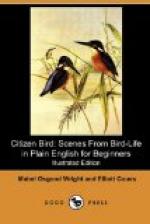The Orchard Oriole
Length seven inches.
Male: black; the rump, breast, belly, and lesser wing-coverts chestnut. Round black tail with whitish tips, and some whitish on the wings.
Female: grayish-green on the upper parts, greener on the tail, with paler bars on the wings; dull yellow on all the under parts.
The young male is like the female the first year, but a little browner on the back; next year he has a black throat; then he patches up his clothes till he looks like his father, all black and chestnut.
A Summer Citizen of the United States, west to the plains, north to some parts of the Northern States and Canada, travelling entirely south of the United States to spend the winter.
A pleasant though shy neighbor, and very good Citizen, belonging to the Ground Gleaners, Tree Trappers, and Seed Sowers. Eats a little cultivated fruit for dessert, and should be welcome to it.
THE BALTIMORE ORIOLE
(THE HAMMOCK-MAKER)
“The Baltimore Oriole is not so shy as his brother, and rather relies on keeping his nest out of sight than himself out of mind. His home is a sort of hempen hammock, only deeper and more pocket-shaped, to keep the babies from falling out, as Nat and Dodo both did out of our hammock yesterday.”
“This nest Mrs. B. Oriole twines herself, from plant fibres, adding strings of cotton or worsted when she has a chance to find any. She secures it to the end of a strong supple twig, usually at a good height from the ground, and she likes an elm tree best of all, because it is not easy for cats or House People to climb far out on the slender swaying branches. Up there the eggs and young are safely rocked by the wind and sheltered by leaves. A cat may look at a king, and also at an Oriole’s nest, but the looking will not do her much good in either case.
[Illustration: Baltimore Oriole.]
“Mamma Oriole sits on the nest, which is almost closed over her head, and keeps all safe. Though she does not sing to House People, how do we know but what she whispers a little lullaby like this, on stormy nights, to her nestlings?
“Rains beat! Winds blow!
Safe the nest in the elm tree.
Days come!
Nights go!
Birds at rest
in the elm tree.
To-and-fro, to-a-n-d-fro,
Safe are we from every foe—
Orioles in the
elm tree.
Cats come! Cats go!
Lullaby in the elm tree!
“Meanwhile B. Oriole does a great deal of work, for he is a tireless member of the guilds of Tree Trappers and Ground Gleaners, eating hosts of caterpillars, wireworms, and beetles. When he is very thirsty he does, now and then, take a sip of the fruit he has helped to save, and once in a while he may eat a few green peas. But would any one refuse a mess of peas to a neighbor in the next house? Then why should you begrudge a few to neighbor B. Oriole? He doubtless paid you for them before he took them, or will do so before long.




